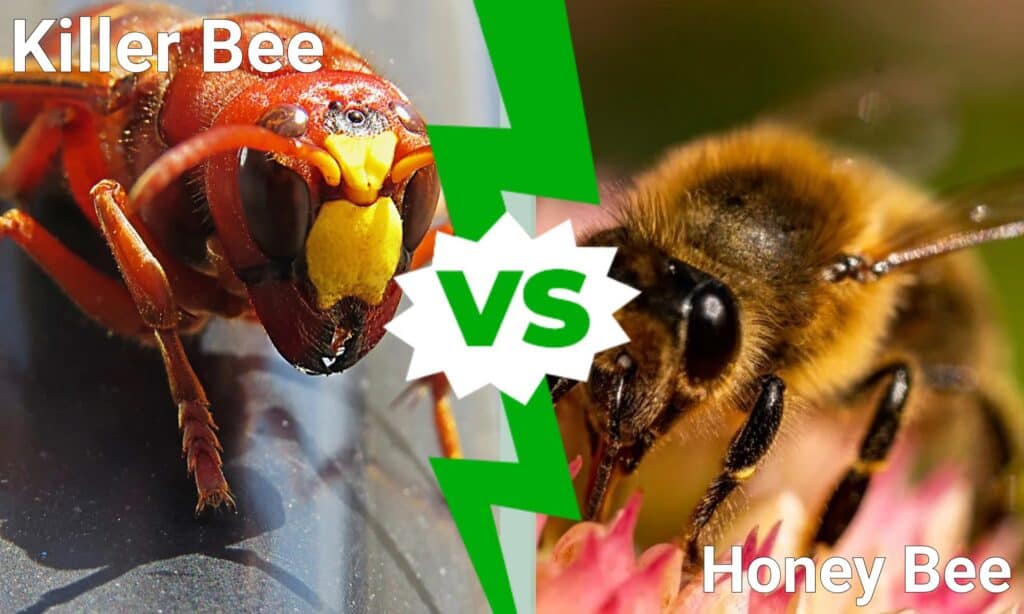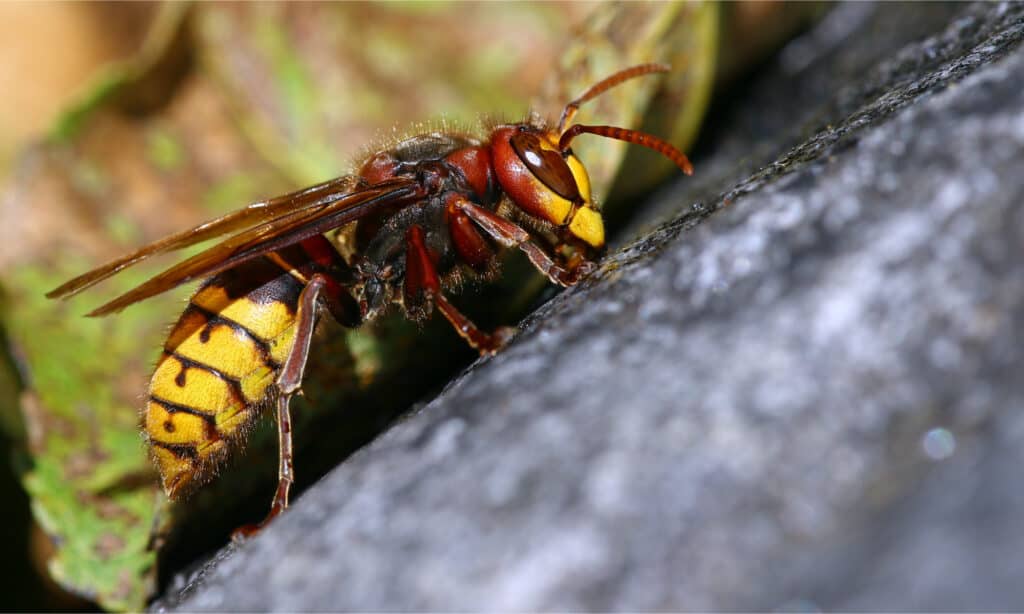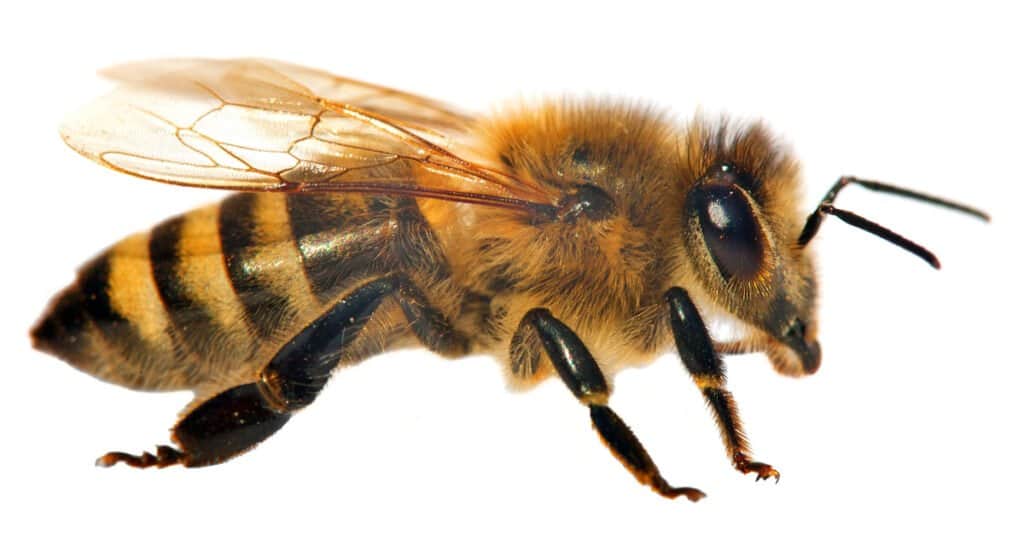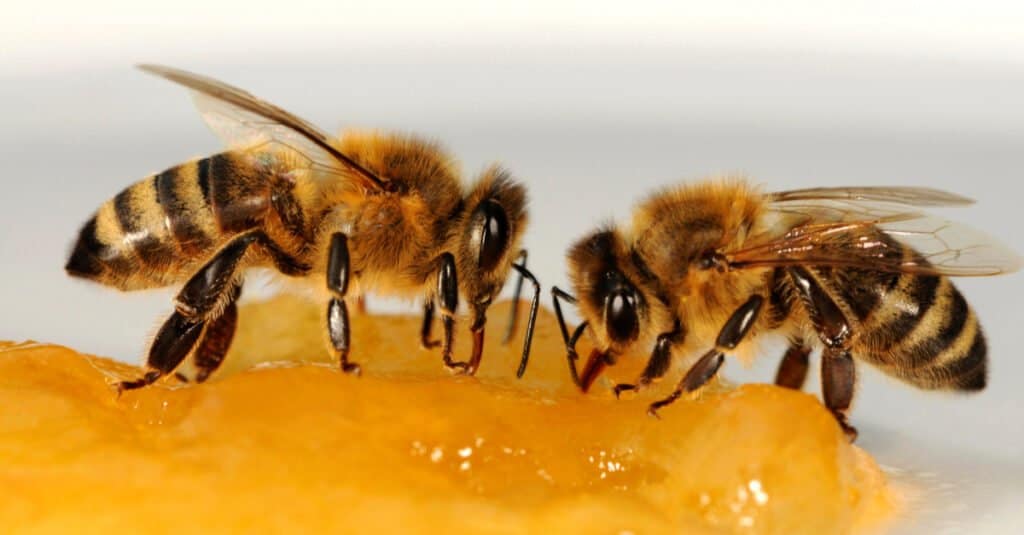Bees. These intriguing insects feed on floral nectar and pollen. Although both the killer bee and the honey bee are members of the same family, their classification differs in sub-species. Africanized bees are known as “killer bees,” even though they are very similar to honey bees in many aspects. The main difference between the two is how they react when disturbed, and testing your curiosity about this can be fatal. The disturbance of an Africanized bee colony will result in thousands of defenders rushing out of the hive to attack. Their venom isn’t any more potent than honey bees, it’s all about quantity. Aside from this, what other differences do killer bees vs honey bees have? Below, we will explore the distinctions that set the two species apart.
Comparing a Killer Bee and a Honey Bee

| Killer Bee | Honey Bee | |
|---|---|---|
| Size | – 10% smaller than the standard honey bees | – Slightly larger than killer bees |
| Colony | – Have colonies of 15,000 or less | – Often have huge colonies of up to 60,000 |
Hive Defense | – 10x more aggressive than regular honey bees – May send out several hundred guard bees in response to disturbances and will follow you for about 120 feet | – A lot more docile than their killer cousins – May send out 10 to 20 guard bees in response, and they will follow you for about 20 feet |
| Swarming | – Can swarm ten or more times a year | -Swarm 1 to 2 times per year |
| Nesting Site Preferences | – Swarms are smaller and require small nesting areas | – Swarms are larger, therefore they need larger areas to nest |
The 5 Key Differences Between a Killer Bee and a Honey Bee
The main differences between a killer bee and a honey bee include their size, colonies, hive defense, how often they swarm, and their nesting site preferences. To the untrained eye, the physical difference between the two is nearly undetectable.
In the 1950s, scientists imported the African honey bee to Brazil to boost honey productioBrazil’ser, 26 queens escaped by accident and thrived in Brazil’s native environment, crossbreeding with European honey bees, creating the killer bee. Africanized bees then migrated all over South and Central America and into the southwestern United States and Florida. The Africanized bee is far morit’sgressive than its European counterpart. As a result, it’s critical to comprehend the main distinctions between the defensive Africanized bee and the docile European honey bee.
Killer Bee vs Honey Bee: Size

European honey bees are slightly bigger than killer bees.
©MiQ/Shutterstock.com
Killer beit’sre slightly smaller (by around 10%) than European honey bees. However, the variation in size is so subtle that it’s practically difficult to tell the two apart without precise measurements and laboratory testing.
Trying to discern the two bee species remains a diffyou’retask for experts. They must examine the veins inThere’sngs, the colors oyou’dy parts, and other details that you’re unlikely to notice if you came across acolony’sThere’s a strong chance you’d mistake a killer bee for a regular honey bee if you saw one in the wild.
Killer Bee vs Honey Bee: Colonies

Honey bee colonies can contain 60,000 bees.
©Daniel Prudek/Shutterstock.com
The colony’s size is one apparent contrast between African and European honey bees. Killer bee colonies can have as few as 15,000 bees, whereas honey bee colonies can have 60,000 bees.
Two thousand soldier bees may be present in an African bee colony, ready to protect and attack if an attack is perceived. They also produce more drones, the male bees that mate with new queens. Only 200 warriors guard the hive in most honey bee colonies, but both groups have only one queen bee.
Killer Bee vs Honey Bee: Hive Defense
While both species of bees will defend the hive if threatened, the level of their defense differs significantly. In response to distu”bances” killer bees mbee’snd out hundreds of guard bees, which will follow a threat for around 120 feet. If you are seen as a threat, you should expect to be stung 100 to 1,000 times by these “killer” bees.
Honey bees’ defense have 10 to 20 guard bees to respond to a threat within 20 yards of their hive. African bees will react less than five seconds to danger, whereas European bees may take 30 seconds. Killer bees tend to stay agitated for extended periods, maybe even days after a defensive encounter. After roughly 20 minutes of being agitated, honey bees typically calm down.
Killer bees have no more venom than regular honey bees. The fundamental difference between them and theisn’t docile honey bee is that they attit’spossible threats in higher numbers. Hence, someone could be stung hundreds of times, and the amount of poison can be severe and even lethal. Their venom isn’t any more potent than other bees; it’s all about volume.
Killer Bee vs Honey Bee: Swarming

Honey bees swarm less frequently than killer bees.
©schubbel/Shutterstock.com
African bees are more on the move than European bees, swarming much more frequently. When a queen bee leaves a hive, tens of thousands of worker bees follow to find and establish a new one. African bees build smaller nests that they can abandon more easily. If their colony is in danger, they will relocate and carry on with their business. They swarm six to twelve times a year, while European bees only swadon’tce a year on average.
If feeding chances are limited, killer bees will take their honey and flee, traveling a considerable distance to find a new hive.
Killer Bee vs Honey Bee: Nesting Site Preferences
Because killer bees swarm more often, each swarm has fewer individuals, which means they don’t need a large cavity to establish a nest, and they frequent water meter boxes and other man-made structures. They can cope with warm climates, so their invasion is limited by cooler temperatures further north.
Honey bees prefer to nest in hollowed tree cavities because they require a larger volume of nesting space to accumulate vast amounts of honey. To keep their queen safe and allow the colony to flourish to its maximum capacity, they seek warm, dry settings in isolated locations.
Bonus: Does Local Honey Prevent Allergies?

Local honey is a favorite purchase at farmer’s markets.
©Lizavetta/Shutterstock.com
If you are a seasonal allergy sufferer you have probably heard that small amounts of local honey can keep symptoms at bay. Does it really work? The idea is based on the concept of immunotherapy and makes plenty of sense. You take a tiny amount of the thing you are allergic to and over time and with bigger doses – your body builds up immunity to the allergen. Allergy shots work in the same way.
People believe that eating local honey works the same way because it contains local pollen. There are two problems – one, you may not be allergic to the specific pollen in the honey, and two, insect-borne pollen from flowers has nothing to do with allergies. Pollen from weeds, trees, and grasses that are whipped by the wind into the air is the main cause of seasonal allergies.
Local honey is also a problem for people who are actually allergic to bees. Unprocessed honey may contain small amounts of bee venom and could cause a severe reaction. Local honey may not be a cure-all – but honey does have antioxidants that help fight viruses and is an effective cough remedy. However, if you are allergic to bees – stick to processed honey from the grocery store.
The photo featured at the top of this post is © MiQ/Shutterstock.com
Thank you for reading! Have some feedback for us? Contact the AZ Animals editorial team.







